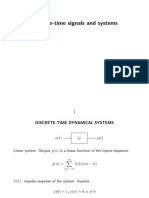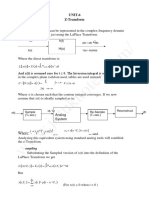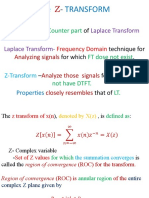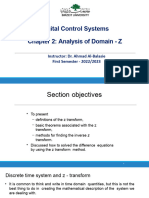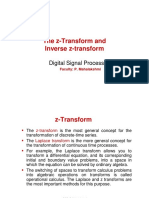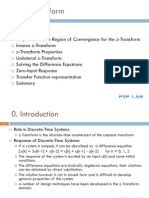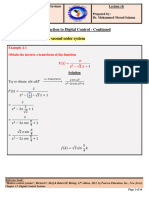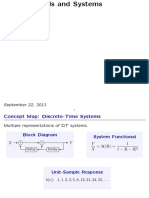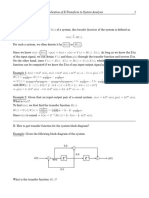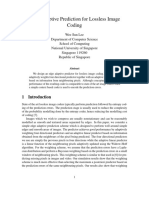0% found this document useful (0 votes)
105 views18 pagesLecture 2: Discrete-Time Systems and Z-Transform
This document summarizes the key topics covered in Lecture 2 on discrete-time systems and the z-transform:
1) It introduces discrete-time signals which are defined at discrete integer times, as opposed to continuous-time signals which are defined continuously.
2) It describes discrete-time linear time-invariant (LTI) systems using difference equations, and how they can approximate continuous-time LTI systems through sampling.
3) It defines the z-transform which transforms a discrete-time signal into a complex function of z, and discusses its properties such as linearity, time-shifting, and use in solving difference equations.
4) It describes how to find the inverse z
Uploaded by
Faheem AbbasiCopyright
© © All Rights Reserved
We take content rights seriously. If you suspect this is your content, claim it here.
Available Formats
Download as PDF, TXT or read online on Scribd
0% found this document useful (0 votes)
105 views18 pagesLecture 2: Discrete-Time Systems and Z-Transform
This document summarizes the key topics covered in Lecture 2 on discrete-time systems and the z-transform:
1) It introduces discrete-time signals which are defined at discrete integer times, as opposed to continuous-time signals which are defined continuously.
2) It describes discrete-time linear time-invariant (LTI) systems using difference equations, and how they can approximate continuous-time LTI systems through sampling.
3) It defines the z-transform which transforms a discrete-time signal into a complex function of z, and discusses its properties such as linearity, time-shifting, and use in solving difference equations.
4) It describes how to find the inverse z
Uploaded by
Faheem AbbasiCopyright
© © All Rights Reserved
We take content rights seriously. If you suspect this is your content, claim it here.
Available Formats
Download as PDF, TXT or read online on Scribd
/ 18




